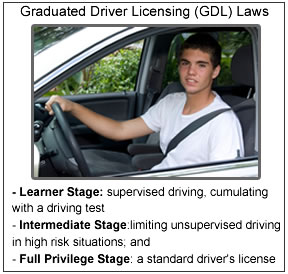Tag Archive: first time driver

Teens Most Likely To Crash In Their First Month Of Solo Driving
August 16, 2012
- failure to reduce speed,
- inattention, and
- failure to yield.

Graduated Drivers License Laws Around the United States
June 3, 2010
Young drivers in the United Stares are subject to many different laws, regulations and procedures. Many of the rules, regulations, privileges and limitations are similar from state to state but some also differ greatly. It would be overwhelming to compare the rules and regulations young drivers face in all 50 states. It’s easier to compare the policies of a handful of states. Many states differ on age young drivers can obtain their learner’s permits and driver’s licenses; they also differ on nighttime driving and passenger restrictions. Additionally the amount of supervised driving various from state to state and the length of time a young driver needs to have a learner’s permit before they can obtain a driver’s license various as well.
Minimum Age to Obtain a Leaner’s Permit
Many states allow teenagers to get their learner’s permits once they have turned 15. The minimum age to obtain a learner’s permit in Florida, Georgia and Texas is 15. In Colorado and Illinois 15 year olds can obtain their learner’s permits if they are enrolled in drives education. In California, teenagers must be 15 years and 6 months old before they can obtain their learner’s permits. Teenagers in New York are ineligible to obtain their permits until they turn 16.
Requirements to obtain a Driver’s License
After obtaining their learner’s permits young drivers are required to possess their permits for a specific amount of time until they are able to take their road tests (assuming they have reached the minimum age to take the toad test). In California, Texas and New York young drivers are only required to have a permit for six months before they take the road test for their driver’s licenses (or restricted licenses). In Illinois a permit is required for nine months before the road test can be taken. Colorado, Florida and Georgia require young drivers to keep their permits of a minimum of 12 months.
Before young drivers are able to get their licenses they are required to log a specific be amount of time behind the wheel. Most states require that 50 hours of driving time be completed and that 10 or 15 of those hours include nighttime driving. However, Texas only requires that 20 hours of driving being completed. But, at least 10 out of the 20 hours needs to be nighttime driving. Georgia requires that drivers complete at least 40 hours of driving and that at least 6 of the hours are night time driving.
In order to obtain a driver’s license or restricted license most states require that driver’s be at least 16 and have taken driver’s education. In order to get a driver’s license without taking a driver’s education course most states require the drivers to be 17 or 18. New York State issues a junior license to 16 year olds who have held their permits for at least 6 months. If they take driver’s ed they are eligible for their senior licenses at 17, if not, they must wait until their 18. For 16 year olds in Florida, they can take the road test for their license when they turn 16 regardless if they have taken driver’s education.
Driver’s License Restrictions
Most states do not give newly licensed 16 year old boys and girl complete freedom behind the wheel. Most states have nighttime driving restrictions and many states have restrictions on the number of passengers young drivers can have in their vehicles. For example, 16 year old drivers in Florida are not permitted to drive between 11pm – 6 am and 17 year old drivers in Florida are not permitted to drive between 1 am – 5 am. Drivers in New York adhere to restrictions from 9 pm – 5 am. And drivers in Colorado and Texas adhere to nighttime driving restrictions from 12 am – 5 am.
Out of the seven states compared here, Florida is the only one that does not have a restriction in place for the number of passengers young drivers are allowed to have in their vehicles. In California, for the first 12 months young drivers are not allowed to have any non-immediate family passengers under the age of 20 in their vehicles. In Colorado and Georgia, drivers are restricted to zero passengers for the first six months they have their license and no more than one for the second six months. In Texas, Illinois and New York young drivers are not allowed to have more than one passenger under the age of 21 in the vehicle. Again, immediate family members are an exception to the rule.

Graduated Driver Licensing Laws: A Comparison
April 8, 2009
A national model for Graduated Driver Licensing Programs has existed since the mid 1990s. The model provides guidelines for states to create their own GDL programs. Currently, no state follows all the guidelines, and GDL programs vary widely from state to state.
The recommended guidelines are:
Stage 1: Learner’s Permit
- State sets minimum age for a learner’s permit at no younger than age 16;
- Pass vision and knowledge tests, including rules of the road, signs, and signals;
- Completion of basic driver training;
- Licensed adult (who is at least 21 years old) required in the vehicle at all times;
- All occupants must wear seat belts;
- Teenage-passenger restrictions;
- Zero alcohol while driving;
- Permit is visually distinctive from other driver licenses;
- Must remain crash and conviction free for at least six months to advance to next level;
- Parental certification of 30 to 50 practice hours; and
- No use of portable electronic communication and entertainment devices.
Stage 2: Intermediate (Provisional) License
- Completion of Stage 1;
- State sets minimum age of 16.5;
- Pass a behind the wheel road test;
- Completion of advanced driver education training (safe driving decision-making, risk education, etc.)-All occupants must wear seat belts;
- Licensed adult required in the vehicle from 10 p.m. until 5 a.m. (e.g., nighttime driving restriction);
- Zero alcohol while driving;
- Driver improvement actions are initiated at lower point level than for regular drivers;
- Provisional license is visually distinctive from a regular license;
- Teenage-passenger restrictions: not more than one teenage passenger for the first 12 months of intermediate license. Afterward, limit the number of teenage passengers to two until age 18;
- Must remain crash and conviction free for at least 12 consecutive months to advance to the next stage;
- Supervised practice; and
- No use of portable electronic communication and entertainment devices.
Stage 3: Full Licensure
- Completion of Stage 2;
- State sets minimum age of 18 for lifting passenger and nighttime restrictions; and
- Zero alcohol while driving.
Source: National Highway Traffic Safety Administration
To understand the range of differences among states, let’s examine the GDL laws of four states: California, Florida, Mississippi, and North Dakota.
The NHTSA recommends that the state sets the minimum age for a learner’s permit at no younger than age 16. In California, the minimum age for a learner’s permit is 15 years, six months; in Florida and Mississippi, the minimum age is 15. The minimum age in North Dakota is 14.
Before getting a license or restricted license in Florida, new drivers must have a mandatory holding period of the learner’s license of twelve months; the other three states require six months. In Mississippi, license applicants age 17 and older are exempt from the holding period. The NHTSA recommends an intermediate (provisional) stage with a minimum age of 16.5. The applicant must remain crash and conviction free for at least six months to advance from the learner’s permit to the intermediate level. They further recommend that in the intermediate license stage, the applicant must remain crash and conviction free for at least 12 consecutive months to advance to full licensure.
The NHTSA recommends parental certification of 30 to 50 practice hours of driving in the learner’s permit stage. While California and Florida each require 50 hours, 10 of which must be at night, neither Mississippi nor North Dakota require certification of any driving practice hours.
Applicants in Mississippi must be age 15 years, six months before getting a license or restricted license. Florida, North Dakota, and California require a minimum age of 16; however, in California, license applicants who do not take driver education must wait until age 18 for a license. The NHTSA recommendation is for full licensure only after completion of the intermediate licensing stage, with a minimum age of 18 for lifting passenger and nighttime restrictions. However, North Dakota does not have any passenger or nighttime restrictions, and Florida and Mississippi have only nighttime restrictions. California’s passenger restriction is that for the first 12 months, the restricted driver may have no passengers younger than 20, with limited exceptions for immediate family.
One way to improve the traffic crash figures for teenage drivers is to advocate for stronger Graduated Driver Licensing requirements in your state. In the meantime, you can reduce the risks for your own children by ensuring that they obey existing GDL laws and by implementing some of the NHTSA’s guidelines into your own house rules if your state has relatively weak GDL laws.
